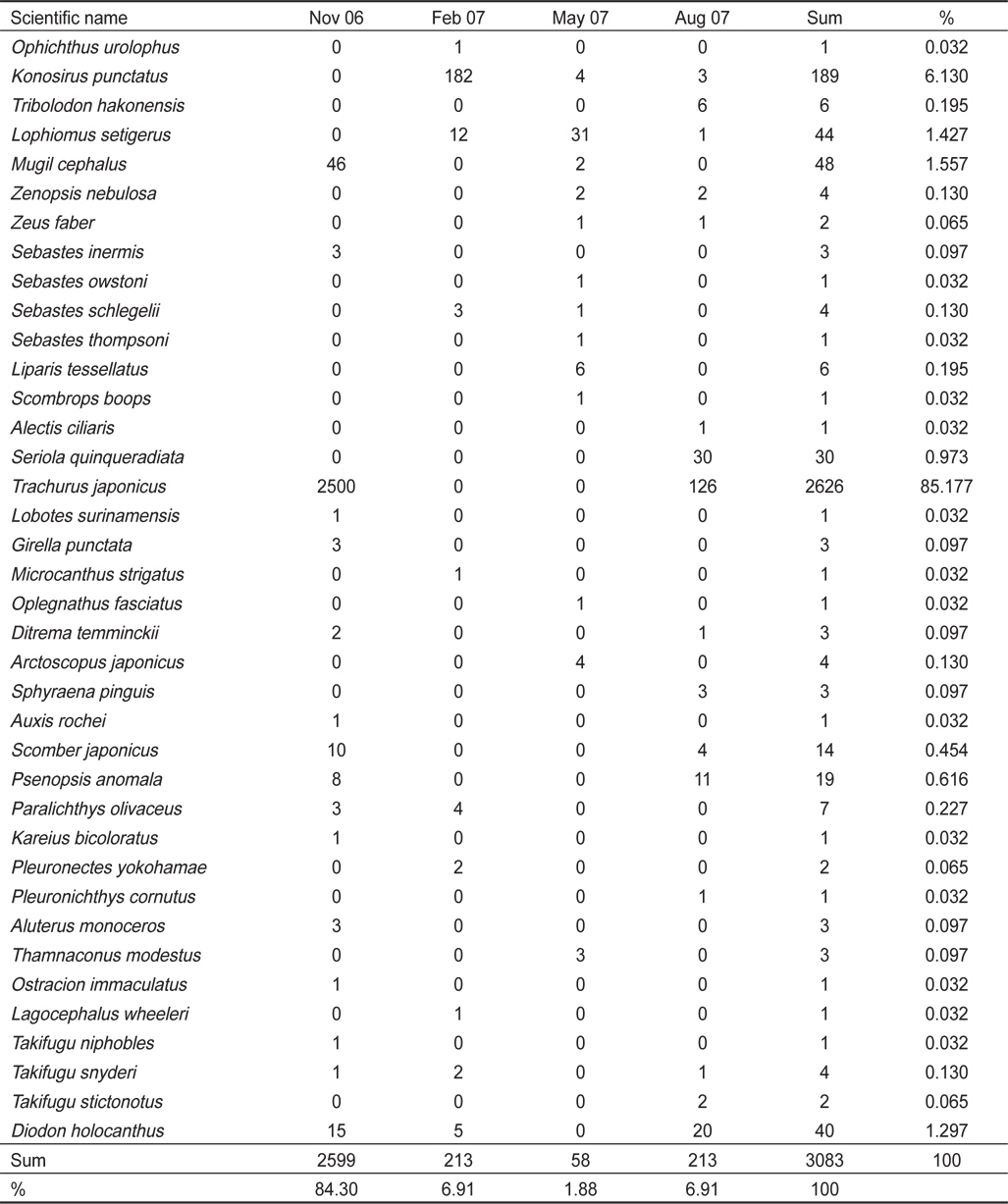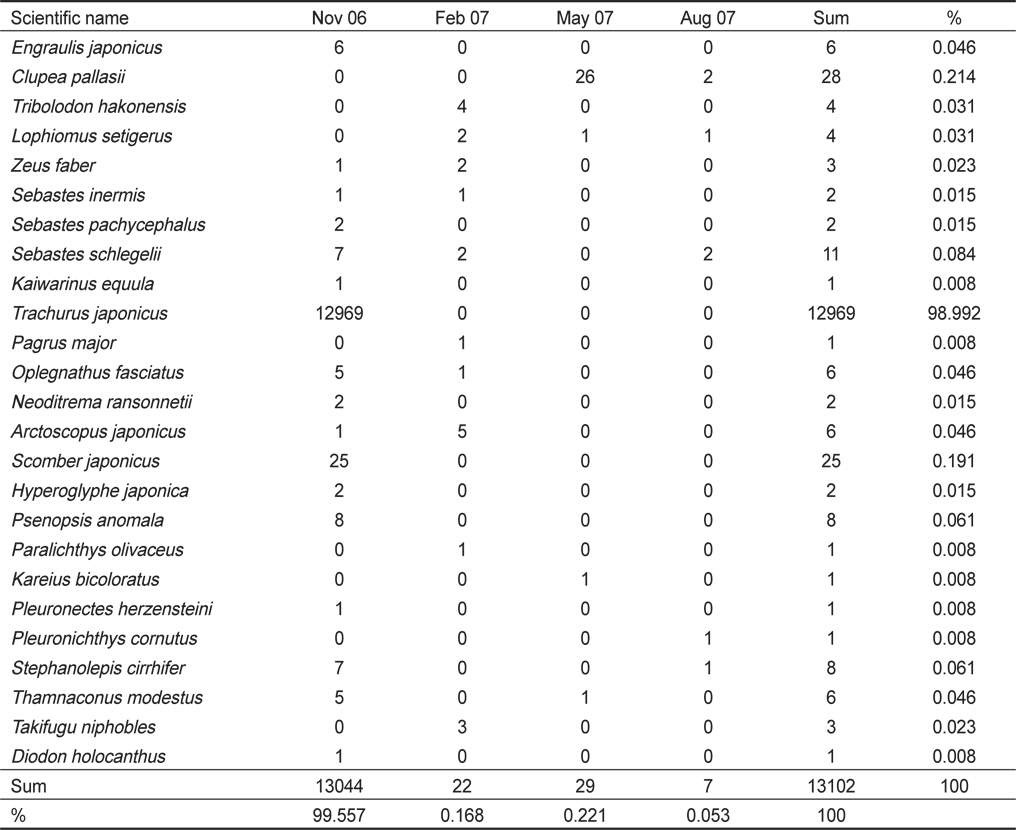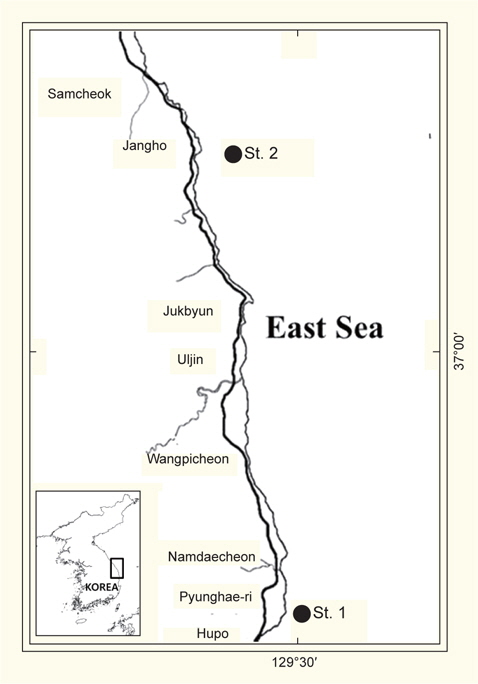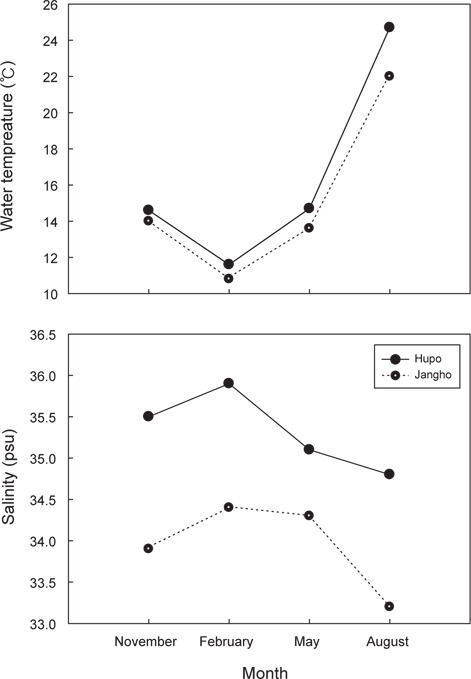



Two major temperature fronts, the Subpolar (Gosung, Gang-won-do; 38°-41° N) and Thermal (Jukbyun, Gyeong-sang-buk-do; 36°-37° N) fronts, are found in the East Sea along the east coast of Korea. These are located roughly where the Tsushima Warm Current and North Korea Cold Current intersect. To clarify the effect of the Thermal Front, we investigated seasonal variation in fish species composition using set nets in two areas located north (Jangho, Gang-won-do) and south (Hupo, Gyeong-sang-buk-do) of Jukbyun, Gyeong-sang-buk-do, and compared the sea water temperature and salinity. We collected a total of 38 fish species in Hupo and 25 in Jangho.
우리나라 동해는 해안선이 단조롭고, 섬과 만이 거의 없으며, 해류 역시 매우 단조로운 구조를 이룬다. 동해는 수심 300-400 m의 표층수와 그 이심의 동해고유수로 구분되며, 동해의 해황은 이들 두 수괴의 상호작용으로 변동한다. 또한, 동해에는 북상하는 대마난류와 남하하는 북한한류가 북위 38-41° 부근에서 충돌하여 동서방향으로 아극전선(subpolar front)이 형성된다(Isoda, 1991; Cho et al., 2004). 그외 동해 남부의 대마난류 수괴를 중심으로 주변의 수괴들이 만나 형성되는 상대적으로 불안정한 열전선이 존재한다(Choi et al., 2010). 동해에 형성되는 것으로 알려진 다양한 전선은 동중국해에서 산란된 고등어, 전갱이, 꽁치 등 회유성 어종의 유어가 동해로 수송되는 도중에 풍부한 먹이를 제공해 준다(Cho et al., 2004). 이처럼 전선역은 풍부한 생산력으로 다양한 해양생물이 서식하기에 적합하며(Browan and Easias, 1977; Gong and Son, 1982), 전선역이 생물에 미치는 영향에 대해 동물플랑크톤(Park et al., 1998; Rebstock and Kang, 2003), 오징어(Cho et al., 2004), 멸치(Lee and Kim, 2007) 등을 대상으로 한 연구가 있으나 어류 분포에 관한 연구는 없다.
우리나라 동해에 출현하는 어류는 439종(Kim and Nam, 2003)으로, 제주도 619종(Kim and Lee, 1994), 서해 304종(Lee, 2003), 남해 301종(Han, 2003)과 비교하면 두번째로 다양한 어종이 출현하는데, 이는 동해에 난류성 및 한류성 어종이 공존하기 때문이다(Lee, 2011). 동해에서 수행된 어류상 조사로는 경남 울산에서 정치망으로 6회 89종(Han et al., 2002), 경북 영일만에서 정치망으로 12회 82종(Han et al., 1997), 강원도 고성에서 정치망으로 4회 36종(Ryu et al., 2005) 등 단편적인 보고만 있을 뿐 동해 전선이 어류분포에 미치는 영향에 대한 연구는 없다.
본 연구에서 조사 대상으로 삼은 정치망 어업은 회유성 어군을 유도해서 어획하는 소극적인 어업이지만, 채집효율이 높고 다양한 어류를 채집하기에 매우 적합한 것으로 알려져 있다(Go and Shin, 1988; Cha et al., 2001, 2004; Kim et al., 2003). 특히 정치망에서 어획되는 어류 종조성은 비교적 뚜렷한 계절 변동을 보이기 때문에(Hwang et al., 2006) 전선이 어종 분포에 미치는 영향을 파악하기에도 매우 적합할 것으로 생각된다. 따라서, 본 연구는 동해에 형성되는 2개의 전선 중 동해남부(경상북도)와 중부(강원도) 사이에 형성되는 불완전한 열전선을 중심으로 수온/염분의 계절 변동과 어류 종조성의 계절변동을 비교하고자 한다.
본 연구는 2006년 11월부터 2007년 8월까지 계절별(11, 2, 5, 8월)로 총 4회 경상북도 울진군 후포 및 강원도 삼척시 장호(Fig. 1)의 2개 지역에서 정치망 조사를 실시하였다. 정치망에서 1일간 어획된 어류는 전량 채집하여 종조성 조사를 실시하였다. 채집된 어류는 빙장상태로 실험실로 운반 후 Nakabo (2002), Kim et al. (2005)을 참고하여 종을 동정하였으며, 종별 개체수와 중량을 측정하였다. 종다양도지수(H')는 Primer program version 6.0을 이용하여 구하였다(Shannon and Wiener, 1963). 본 연구에서 채집된 어종은 Froese and Pauly (2014)에 따라 아열대성, 온대성, 아한대성으로 하였다. 한편, 조사기간 중 후포와 장호의 수온 및 염분자료는 국립해양조사원 국가해양관측정보망(KHOA, 2014)에서 자료를 수집하여 분석에 활용하였다.
국립해양조사원 국가해양관측정보망에서 수집한 수온, 염분 자료에 의하면, 11월 후포는 14.6℃, 장호는 14.0℃, 2월은 각각 11.6℃, 10.8℃, 5월은 14.7℃, 13.6℃, 8월은 24.7℃, 22.0℃였다. 염분은 11월 후포는 35.5 psu, 장호는 33.9 psu, 2월은 35.9 psu, 34.4 psu, 5월은 35.1 psu, 34.3 psu, 8월은 34.8 psu, 33.2 psu였다. 이상의 결과에서, 표층수온과 표층염분은 후포가 장호에 비해 고온고염으로 나타났다(Fig. 2).
후포에서는 총 10목 24과 38종이 채집되었으며, 계절별 종수를 보면 11월(16종)과 8월(16종)에 가장 많은 종이 채집되었고, 5월(13종)과 2월(10종)에는 비교적 적은 종수가 채집되었다. 개체수는 11월(2,599개체)에 가장 많은 개체가 채집되었으며, 5월(58개체)에 가장 적게 채집되었다. 종다양도지수(H’)는 개체수가 가장 적게 채집된 5월(1.74)에 가장 높았고, 개체수가 최대였던 11월(0.23)에 가장 낮았다. 우점 분류군 현황을 보면, 목(order) 수준에서는 농어목이 10과(86.2%)로 가장 우점하였고, 과(family) 수준에서는 양볼락과 및 참복과 어류가 각 4종(16.7%)으로 우점하였다. 또한, 개체수에서 전갱이가 2,626개체(85.2%)로 가장 우점하였으며, 이어 전어 189개체(6.1%), 가시복 40개체(1.3%) 순으로 우점하였다. 한편, 계절별 우점종은 11월에 전갱이, 2월에 전어, 5월에 아귀, 8월에 전갱이가 각각 우점하였다(Table 1, Fig. 3).

The number of individuals for fish species collected by set net at Hupo, Gyeong-sang-buk-do, between November, 2006 and August, 2007
장호에서는 총 8목 18과 25종이 채집되었고, 계절별 종수는 11월(17종)에 가장 많았고, 이어 2월(10종)에 비교적 많은 종수가 채집되었으나, 5월(4종)과 8월(5종)에는 종수가 현저히 줄어들었다. 개체수는 11월(13,044개체)에 가장 많이 채집되었으며, 8월(7개체)에 가장 적게 채집되었다. 종다양도지수(H’)는 개체수가 많이 채집된 11월(0.05)에 가장 낮았고, 개체수가 비교적 적고 종수가 많았던 2월(2.13)에 가장 높았다. 우점 분류군 현황을 보면, 목 수준에서는 농어목이 7과(38.9%)로 가장 우점하였고, 과 수준에서는 양볼락과 및 가자미과 어류가 각 3종(12.0%)으로 우점하였다. 개체수에서 전갱이가 12,969개체(99.0%)로 가장 우점하였으며 이어 청어 28개체(0.2%), 고등어 25개체(0.2%) 순으로 나타났고, 계절별로는 11월에 전갱이, 2월에 도루묵, 5월에 청어, 8월에 청어/조피볼락이 우점하였다(Table 2, Fig. 3).

The number of individuals for fish species collected by set net at Jangho, Gang-won-do, between November, 2006 and August, 2007
본 연구는 동해 남부와 중부 사이에 형성되는 열전선이 회유성 어류 분포에 미치는 영향을 구명하기 위하여 2006년 11월부터 2007년 8월까지 경상북도 울진군 후포와 강원도 삼척시 장호의 2개 지역에서 정치망으로 어류 종조성의 계절변동을 조사하였다. 이 두 지역을 선정한 이유는 동해 남부와 중부가 경상북도 죽변을 경계로 구분되는데(Kim et al., 2012), 후포는 죽변의 남부(동해남부), 장호는 죽변의 북부(동해중부)에 위치하기 때문이다.
조사결과, 동해남부(후포)에서는 10목 24과 38종, 동해중부(장호)에서는 8목 18과 25종이 채집되어 동해남부(후포)가 동해중부(장호)보다 다양한 어종이 출현하였다. 흥미로운 점은 두 지역에서 채집된 어종을 비교한 결과 Froese and Pauly (2014)가 아열대어종으로 분류한 종들이 동해중부(장호)보다 동해남부(후포)에서 더 많이 출현하고 있다는 점이다. 갈물뱀, 객주리, 국매리복, 꼬치고기, 몽치다래, 방어, 백미돔, 범돔, 숭어, 실전갱이, 전어 등 11종은 아열대어류로 분류되는 종들로(Froese and Pauly, 2014) 동해남부(후포)에서만 출현한 어류이다. 이들 어류의 출현시기를 보면 수온이 가장 높은 8월(Fig. 3)에 집중되며, 두번째로 높은 11월에도 출현하는 양상을 보였다(Table 1).
한편, 계절별로는 5월과 8월에 동해남부(후포)가 동해중부(장호)보다 훨씬 다양한 종이 출현하여 두 해역간 뚜렷한 차이를 보였다. 그중 5월의 경우 동해남부(후포)가 동해중부(장호)에 비해, 아열대 및 온대어류가 다양하게 출현하는 경향을 보였다. 특히, 8월에는 그 차이가 분명해지는데, 동해남부(후포)에는 전어, 실전갱이, 방어, 꼬치고기, 고등어, 샛돔, 국매리복, 가시복 등 아열대어류가 대거 출현하는 반면, 동해중부(장호)에는 쥐치, 청어 등 온대 또는 아한대 어류가 주요하게 출현하는 양상을 보였다. 즉, 동해남부(후포)가 동해중부(장호)에 비해 다양한 어류가 출현하는 동시에 아열대어류의 출현빈도가 더 높다는 것을 알 수 있다.
조사지역인 동해남부(후포)와 동해중부(장호)가 약 70 km 떨어진 가까운 거리임에도 불구하고, 어류 종조성에서 비교적 명확한 차이를 보이는데, 이는 수온과 염분 차이에서 기인한 것으로 추정된다. 국립해양조사원 국가해양관측정보망에서 수집한 수온, 염분자료에 의하면, 표층수온은 동해남부(후포)가 동해중부(장호)보다 연중 0.6-2.7℃ 높고, 표층염분은 동해남부(후포)가 동해중부(장호)보다 연중 0.8-1.6 psu 높은 것을 알 수 있다(Fig. 2). 이는 동해 남부와 중부가 강원도 죽변을 경계로 구분된다는 이전 학자의 견해(Kim et al., 2012)를 지지해 주는 것으로 향후 보다 광범위한 지역을 대상으로 세밀한 조사를 수행한다면 해양학적 경계가 생태계에 미치는 영향을 이해하는데 도움을 줄 수 있을 것이다.
두 지역에서 공통적으로 극우점하게 출현했던 전갱이는 전장 5-10 cm 유어가 주로 채집되었는데, 이들 유어는 해류를 따라 북상하면서 동해남부(후포)와 동해중부(장호) 사이에 형성되는 열전선의 영향을 적게 받는 것으로 추정된다. 즉, 전갱이가 표층수온이 낮은 동해중부(장호)에서도 출현할 수 있었던 것은 전갱이가 다른 어류와 달리 온대성 어류이기 때문으로 사료된다(Froese and Pauly, 2014).
본 연구결과와 동해 다른 지역에서 수행된 정치망 연구결과를 비교하면, 경상남도 울산은 6회 89종(Han et al., 2002), 경상북도 영일만은 12회 82종(Han et al., 1997), 강원도 고성은 4회 36종(Ryu et al., 2005)으로, 본 연구에서 경상북도 후포 4회 38종, 강원도 장호 4회 25종의 출현종수를 나타내어 남에서 북으로 갈수록 정치망에서 출현하는 어류의 종수는 감소하는 경향을 보인다. 특히, 수온, 염분 등 환경변화가 심한 전선의 북쪽에 인접한 강원도 장호의 경우, 종수가 급격히 감소하는 것으로 보아, 급격한 환경변화가 회유성 어종의 지리적 장벽 역할을 하는 것으로 추측된다. 이를 증명하기 위해서는 매월 조사 등과 같은 집중 조사가 필요하다.
사계절 모두 수온과 염분이 높았던 동해남부(후포)에서 아열대어류의 출현빈도가 더높게 나타난 본 연구결과를 통해, 동해남부(후포)와 동해중부(장호) 사이에 해양학적 장벽 뿐만 아니라 생물지리학적 장벽도 존재할 것으로 추정된다. 우리나라에서 생물지리학적 장벽에 관한 연구는 까나리(Kim et al., 2006), 무늬발게(Hong et al., 2012), 거북손(Yoon et al., 2013), 전어(Myoung and Kim, In press) 등을 대상으로 비교적 최근에 활발한 연구가 진행중이다. 이 결과를 종합하면 동해에 뚜렷한 생물지리학적 장벽이 존재한다는 것을 제시하고 있다. 본 연구에서 처음으로 조사가 이루어진 동해남부와 중부 사이의 열전선이 회유성 어류의 분포에 미치는 영향을 토대로 향후 좀 더 다양한 연구가 필요할 것으로 사료된다. 또한, 동해중부와 동해북부 사이에 위치하는 아극전선이 어류 분포에 미치는 영향에 대해서도 추가적인 연구가 필요할 것으로 사료된다.




